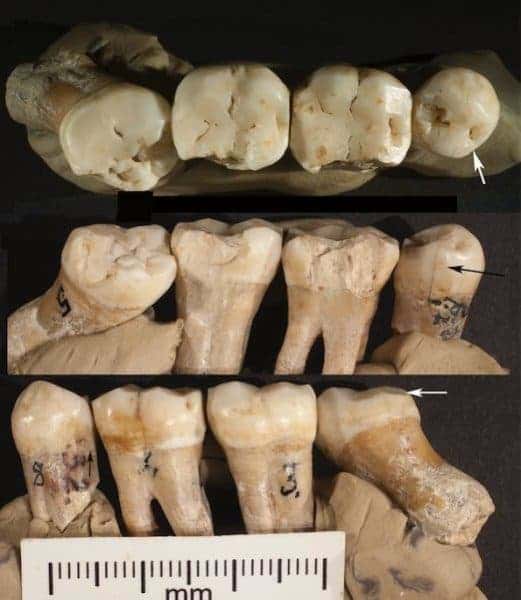Nobody likes a toothache, and that must have included Neanderthals too. New research suggests our extinct cousins practiced a form of prehistoric dentistry as evidenced by multiple toothpick grooves on teeth and signs of other manipulations. The teeth were found at Krapina site in Croatia and have been dated to 130,000 years ago.

Credit: David Frayer, University of Kansas
It’s been more than 100 years since the Neanderthal teeth, premolars, and molars were excavated at the Croation site. It was only recently though, after Davorka Radovčić, curator at the Croatian Natural History Museum, reexamined the remains that the remains’ dentistry insight came to light.
With the help of David Frayer, professor emeritus of anthropology at the University of Kansas, the two used light microscopes to identify occlusal wear, toothpick groove formation, dentin scratches, and ante mortem, lingual enamel fractures.
Unfortunately, the teeth were recovered isolated. It would have been most helpful if they came with a mandible so the scientists could check for any signs of periodontal disease. The scratches and grooves on the teeth are enough, however, to indicate that there was some genuine cause of concern which must have irritated and caused discomfort to the toothaching Neanderthal.
The premolar and M3 molar were pushed out of their normal position and six toothpick grooves were found on the two teeth as well as on the two molars further behind them. Previously, the researchers were able to reconstruct the order and location of the Krapina teeth which belonged to a male and female Neanderthal.
“As a package, this fits together as a dental problem that the Neanderthal was having and was trying to presumably treat itself, with the toothpick grooves, the breaks and also with the scratches on the premolar,” said Frayer in a statement. “It was an interesting connection or collection of phenomena that fit together in a way that we would expect a modern human to do. Everybody has had dental pain, and they know what it’s like to have a problem with an impacted tooth.”
“The scratches indicate this individual was pushing something into his or her mouth to get at that twisted premolar,” Frayer said.
Because the chips on the teeth were on the tongue side of the teeth and at different angles, the team ruled out the possibility that these manipulations happened after the Neanderthal died. As such, the manipulations must have been on purposes, possibly etched with a bone or stem of grass.
“It fits into a pattern of a Neanderthal being able to modify its personal environment by using tools,” Frayer said, “because the toothpick grooves, whether they are made by bones or grass stems or who knows what, the scratches and chips in the teeth, they show us that Neanderthals were doing something inside their mouths to treat the dental irritation. Or at least this one was.”
“It’s maybe not surprising that a Neanderthal did this, but as far as I know, there’s no specimen that combines all of this together into a pattern that would indicate he or she was trying to presumably self-treat this eruption problem,” he said.
There’s this general impression that Neanderthals were mindless brutes, yet with every new discovery this sort of thinking simply doesn’t add up. For instance, from the same Krapina site, anthropologists found a beautiful a set of eagle talons that included cut marks and were fashioned into a piece of jewelry. Could a brute do this?

Neanderthals practiced cave painting and lit fires way before humans. They even used manganese dioxide, today commonly found in batteries, to light fires some 50,000 years ago. There’s more to Neanderthals than meets the eye. One day, their reputation might finally be redeemed.
Scientific reference: David W. Frayer et al. Prehistoric dentistry? P4 rotation, partial M3 impaction, toothpick grooves and other signs of manipulation in Krapina Dental Person 20. Bulletin of the International Association for Paleodontology, June 2017






